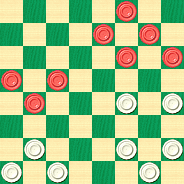Playing Hardball

Following on the heels of last month's "Two Fisted" checker problem, this month we again play real "hardball" with a position that one of the greats of checker history managed to get wrong. More about that when we discuss the solution, but first let's look at the following diagram.

WHITE
White to Play and Win
W:W19,20,25,27,28,29,30,32:B3,7,8,11,12,13,14,17.
The originally published comment on this position was "... the following beautiful position ... appears to be a forced White win." That was something over 85 years ago. Modern computer analysis by KingsRow with the 10-piece endgame database declares the position a likely White win, but with a line of play different from the one published decades back.
In the solution, reached by clicking on Read More, we'll show you the computer line and give you a little more historical background. But first, we invite you to do your own analysis, and at the very least, decide how you would play the position. Certainly, it's a practical exercise, and although indeed we're playing hardball in asking you to do better than one of the game's leading champions of yore, the solution is surprisingly accessible.![]()
Solution
The position came from a game played in a simultaneous exhibition. An amateur player had Black and the great Newell W. Banks had White. In the diagrammed position, Banks played 27-24 and the analysts declared the position won for White. In fact, KingsRow calls it a draw after 27-24! The winning move is 27-23. Of course, history further tells us that Banks won the game after all, his amateur opponent failing to find the best defense (small wonder in such a complex position).
Here's one possible line from the computer solution. As always there are too many possible variants to give here; you should explore further with your own computer if you are so inclined.
27-23 17-21 25-22 14-17 22-18 17-22 18-14 13-17 23-18 7-10 14x7 3x10 32-27 White wins as Black has no safe move.
By contrast, here is the line with 27-24, as actually played by Mr. Banks.
27-24 17-21 25-22 14-18 22x15 11x18 19-15 13-17 24-19 17-22 28-24 22-25 29x22 18x25---A 20-16 25-29 32-27 29-25 30-26 25-30 27-23 21-25 24-20 8-11 15x8 7-10---B
A---It was actually thought by some that Black has a win here!
B---This is Black's downfall and White went on to win. 25-29 is given by the computer to hold the draw.
We find it interesting that the White win with 27-23 is very tidy and seemingly straightforward whereas play after 27-24 is complicated indeed; this makes us wonder why the published analysis didn't consider 27-23. Perhaps it's because, having played 27-24, Mr. Banks won the game anyway, and that was seen as proof enough that 27-24 was the winning move. Black's fatal error later on was fairly subtle and may have simply escaped notice. In any event, there is a playing lesson here for all of us; it's the old maxim that if you find a good move, look for a better one. We do hope you enjoyed today's exercise.
You can email the Webmaster with comments on this article.